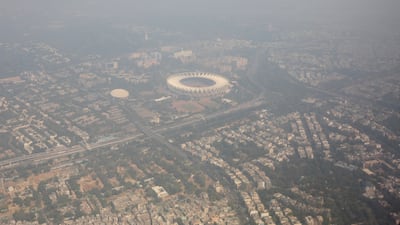One of India's leading technology institutes is planning to create “artificial rain” to mitigate the air pollution crisis in the capital New Delhi.
Professors and researchers at the Indian Institute of Technology (IIT) in Kanpur say they have permission from the government to conduct cloud-seeding operations in an attempt generate rain that would help clear pollutants from the air.
Cloud seeding is a complex process that involves aircraft releasing salt crystals from flares into clouds to trigger rain. Manindra Agrawal, a professor in the institute's computer science and engineering department, who spearheaded the project, said the team was now waiting for the right conditions.
“Artificial rain through cloud seeding has been done before for drought relief in the country, but this will be the first time when an indigenously built cloud-seeding system will be used for pollution control,” Mr Agrawal said.
“We have our own aircraft and over the last few years have installed an attachment on its wings, which is equipped with salt flares. We can take this aircraft below the clouds that will inject a certain mixture of salt into the clouds, which causes rain, provided the clouds have reasonable moisture,” he said.
New Delhi has been experiencing high levels of air pollution since last month and is shrouded in a thick blanket of toxic smog.
The Air Quality Index levels at the city’s Anand Vihar station were 447 on Monday evening, considered "severe".
The government has suspended most school classes and directed its employees to work from home. It has restricted the entry of heavy vehicles into the capital, halted construction works and reintroduced an odd-even traffic rule to certain vehicles can be used only on alternate days to curb pollution.
But the measures have not had much effect so far.
Mr Agrawal said cloud seeding could bring “temporary relief” to the city.
The Kanpur IIT in Uttar Pradesh state, neighbouring Delhi, had been working on an indigenous cloud-seeding system to mitigate drought in the state's Bundelkhand region – one of India’s most arid areas.
“The original idea for building cloud seeding was to provide relief during drought, as done in the Middle East. We started five years ago but due to the Covid pandemic it got delayed.
“Pollution control is not a one-time thing. The dust particles will wash down but then will get collected again, so this must be repeated every couple of weeks.”
Mr Agrawal said the Directorate General of Civil Aviation had given the IIT team the go-ahead for the experiment, but it will have to wait for at least a week for the presence of suitable clouds.
Artificial rain requires specific conditions, such as clouds with adequate moisture and suitable winds.
Mr Agrawal said the team would use a six-seater Cessna plane to release salt from the flares into the clouds to stimulate and accelerate the condensation process that produces droplets big enough to fall as rain.
“A mixture of common salt, but very fine, a few micrometres in diameter, is used. When this salt flare is lit, it throws hot air that rises upwards. The aircraft is flown below the cloud and the hot air takes the mixture into the clouds.
“The moment the mixture goes into the clouds, condensation around each particle, which is tiny, starts, and slowly starts collecting water. Over a couple of hours, the water collected becomes enough to increase its weight and fall, due to gravity, as rain.”



